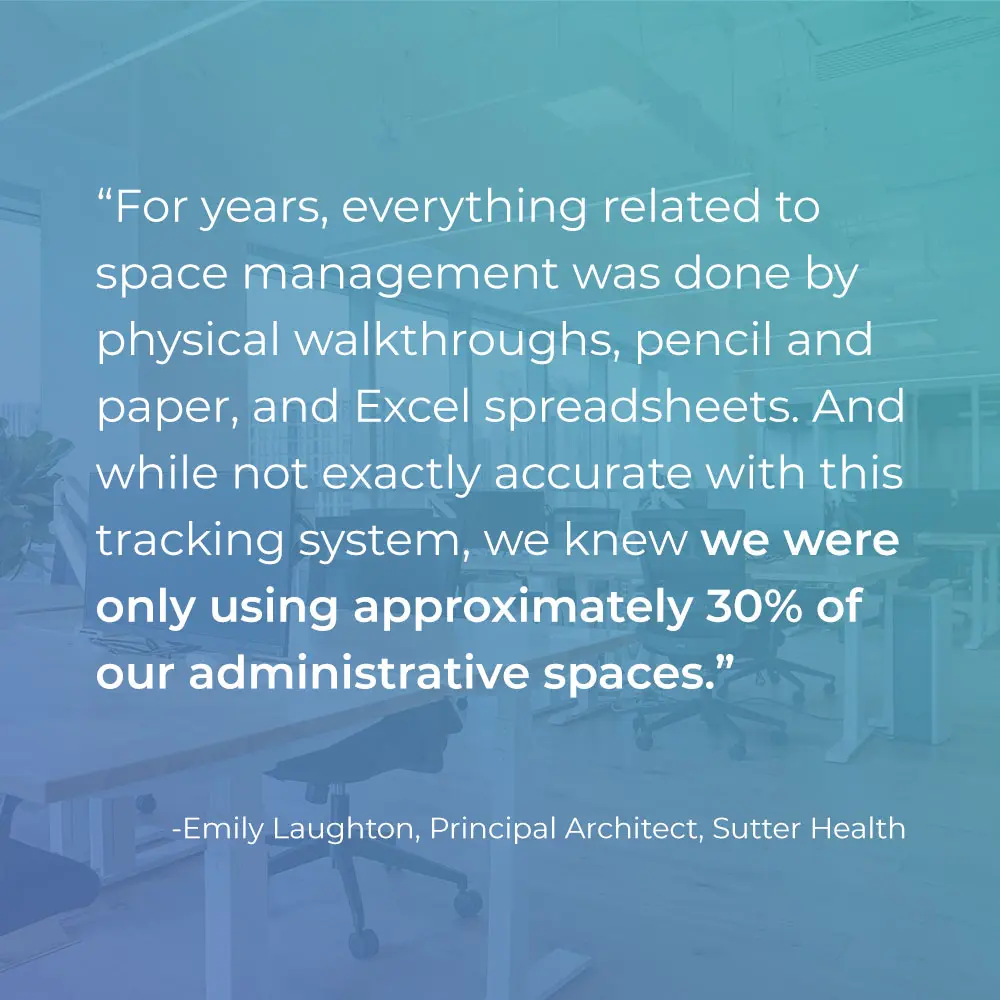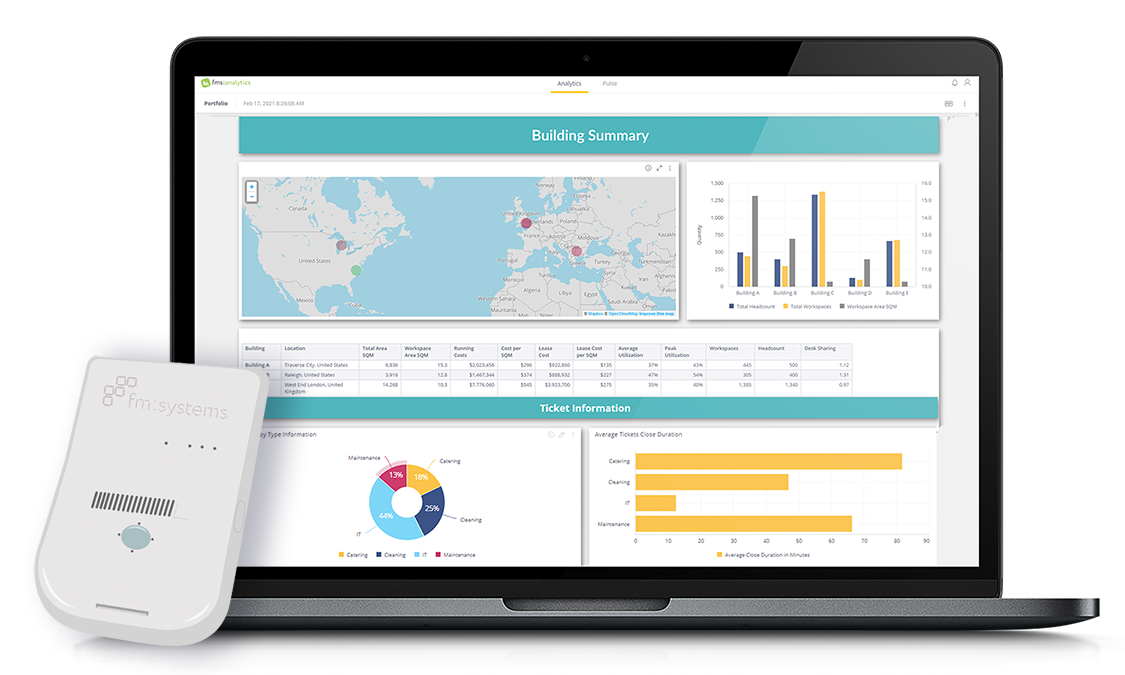Sutter Health
How Sutter Health is using FM:Systems workplace sensors and analytics to aggregate utilization data, produce cost savings among its premium northern California real estate, and enable new work models.
The Customer
Headquartered in Sacramento, Sutter Health is a not-for-profit organization that provides coordinated healthcare to more than 3 million Californians. Its integrated network has created a connected model of care that ensures healthcare is accessible and inclusive to all by offering comprehensive services and quality health programs tailored to the more than 100 diverse communities it serves.
The Challenge
As a not-for-profit system, Sutter Health was looking to make big changes to further lower its costs and be more affordable for its communities. Its focus on affordability was accelerated as Covid-19 closures meant the organization had to prioritize emergency services only. Determining whether or not Sutter Health needed all of its administrative, non-clinical spaces that spanned northern California—notoriously one of the most expensive real estate markets in the US—was an essential starting point to produce savings.
“For years, everything related to space management was done by physical walkthroughs, pencil and paper, and Excel spreadsheets,” said Emily Laughton, principal architect for Sutter Health. “And while not exactly accurate with this tracking system, we knew we were only using approximately 30% of our administrative spaces.”

During this time, Sutter Health also navigated shifting from a 100 percent traditional in-office work model with assigned desks to abruptly engaging an almost entirely remote workforce for the first time in its history. And, like so many employers witnessed during The Great Resignation of 2021, “our organization saw rapid employment changes starting in 2020 for a variety of reasons.,” said Marshall Elliott, Learning Center Coordinator for Sutter Health. “Adapting to remote meetings, working from home, learning new management styles, using more technology on a daily basis, while experiencing employee turnover inevitably was a big adjustment for our culture. We needed a platform that could help us with our immediate real estate needs, but also one that could help us adapt to these new work models.”
With all these moving parts, Sutter Health prioritized finding a solution that not only could identify if and where it made financial sense to rationalize their real estate footprint, but also could help them better understand what kinds of spaces people would actually use when they welcomed back their employees under a more hybrid work approach.
“Adapting to remote meetings, working from home, learning new management styles, using more technology on a daily basis, while experiencing employee turnover inevitably was a big adjustment for our culture. We needed a platform that could help us with our immediate real estate needs, but also one that could help us adapt to these new work models.”
– Marshall Elliott, Learning Center Coordinator, Sutter Health
The Solution
Emily was asked to vet a long list of 11 different integrated workplace management systems (IWMS). In evaluating each, it was clear that FM:Systems was a good fit for two reasons: First, it would enable Sutter Health to gain the utilization data of its facilities it needed now to identify cost-saving opportunities within its administrative sites. And secondly, because it had the widest mix of Workplace Management Solutions that would give the organization the flexibility to later integrate additional solutions as their real estate and workplace needs continue to evolve.

While some of the vendors with single point-solutions seemed to have really user-friendly platforms, Emily noted, “…if we ever wanted to add on a different solution, we’d have to go through the painful process to get multiple vendor agreements signed. This undoubtedly would slow us down tremendously. FM:Systems offered us the ability to pick and choose what we wanted now, but also in the future.”
To address Sutter Health’s most pressing goals to reduce underutilized administrative real estate and the corresponding costs, the organization worked with FM:Systems to set up its workplace analytics solution in early 2021 at 15 sites positioned strategically across northern California. So, when nearly 12,000 administrative employees returned in-person, Sutter Health would be ready with an automated system in place to collect rich, clear and reliable workplace data—and at the scale needed to make informed decisions about their real estate needs.
”FM:Systems offered us the ability to pick and choose what we wanted now, but also in the future.”
– Emily Laughton, Principal Architect, Sutter Health
The Results
Timely Workplace Insights Produce Major Cost-Reduction Opportunities
In the near future, Sutter Health is looking to exit approximately 700,000 square feet of administrative space that could translate to a potential $21 million in cost savings. However, the process of potentially eliminating real estate will be done strategically and certainly won’t happen overnight. “We’re in no hurry to make any rash decisions, especially while we’re currently only using our administrative spaces about 3-10% of the time given much of California is still very much shut down,” said Emily.
“With FM:Systems workplace analytics solution, we can now get the level of true, unbiased insights necessary to really figure out who’s using our buildings and how they’re being used, allowing us to take a long hard look at which spaces are performing well or not,” said Marshall. “This would not have been possible with our previous manual, error-prone tracking method to space management.”
Highly Secure and Compliant Made for Speedy Implementation
“One of the biggest hurdles to integrating any new system as a healthcare organization is how it stands up to our privacy and security requirements,” said Emily. The data powering FM:Systems workplace analytics solution is rigorously managed to protect employee privacy. Before even being transferred, data is stripped of any personal information (PI) and all key identifiers are hashed. All data is encrypted in transmission and at rest. Moreover, the solution is also GDPR-compliant. “Because of these reasons, we were able to contract with FM:Systems in two weeks, which is unheard of in our industry,” said Emily.
Extremely Scalable and Flexible to Stay at Forefront of Future of Work
From shutting down important healthcare services to adopting new work models to undergoing employee turnover as a result of Covid-19, the organization knows anything can happen in an instant. With FM:Systems, Sutter Health can now rapidly fire up more FM:Systems Workplace Management Solutions, enabling it to meet ever-shifting workplace challenges. “The option to use multiple different technologies within the same platform means Sutter Health can move quickly when we’re ready to add on a new module. I hope to eventually integrate more FM:Systems hardware because when we do, we’ll have even more complex data readily available to easily digest within the same dashboard we’re already using.
“The option to use multiple different technologies within the same platform means Sutter Health can move quickly when we’re ready to add on a new module. I hope to eventually integrate more FM:Systems hardware because when we do, we’ll have even more complex data readily available to easily digest within the same dashboard we’re already using.”
– Emily Laughton, Principal Architect, Sutter Health

Planning a flexible workplace strategy? Download our guide.
With a focus on balancing cost-savings and change management, this guide will help you adopt forward-thinking strategies that lay the foundation for growth into a future state that is dynamic, flexible and resilient. What’s included:
- Free downloadable templates
- Additional planning resources
- Cost-savings calculator





